Cruzbike at the A2 Wind Tunnel
February 6, 2017/ Jim Parker
After ten years of making bicycles, we decided to test our fastest model, the Cruzbike V20 performance recumbent bike, in a high-tech wind tunnel in one of the USA’s motorsport hubs, Charlotte, North Carolina. Cruzbike designer Jacob Bouchard flew in from Brooklyn, NY and Product Manager Robert Holler flew in from Portland, OR to help with the testing. Many Cruzbike customers care deeply about the details that go into making themselves faster, and that includes smart training, proper equipment, and attention to the aerodynamic details. We are happy to share the results of this laboratory testing.

What we were testing
The A2 Wind Tunnel measures the force applied by the wind to a bicycle and the person on the bicycle. For meaningful results, the bicycle and rider must be tested together because there are complex interactions that take place between the two. The wind tunnel computer calculates a common measure of drag called Cd*A (CdA). CdA is the product of the frontal surface area (A) and the coefficient of drag (Cd). The lower the CdA, the faster you’ll go for a given power output. In the upright bicycle world the rider must balance an aerodynamic body position against comfort, ergonomics and power generation. For instance, it’s possible for an upright rider to get into a very aerodynamic position on an extreme Time Trial bike and create a relatively low CdA, but that position might be very uncomfortable or difficult for the rider to hold or to produce maximum power.
Our testing was much simpler. On the V20 we’re always in an aerodynamic and ergonomic recumbent position, and the efficient dynamic boom drivetrain allows for high power production. We were just looking for tweaks in equipment and hand and leg position to take full advantage of our speed machines.
Challenges of testing a recumbent
The A2 Wind Tunnel is fully equipped to test cyclists. However, we were the first recumbent cyclists ever to slip through their 30 mph turbine-produced wind. Geoff Eaker, who ran the tests, had to customize brackets to hold our bikes on the delicate precision-balanced platform that measures force in grams. Unfortunately, many of the 75 separate “runs” that we did were invalid due to a rear-wheel clearance issue that wasn’t discovered until we were well into the testing day. Because of this, we didn’t get valid results for some of the items that we wanted to test. Nevertheless, useful results were obtained. All items were tested at 0 yaw (straight headwind) and at a 7.5 degree oblique headwind. All test were done with a rider on the bike; specifically Maria Parker, Larry Oslund, and me.

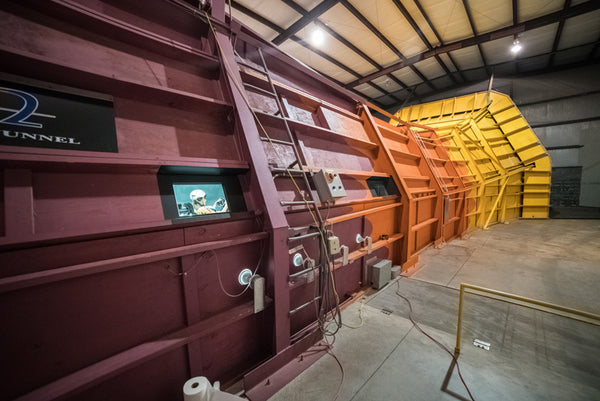


Results
The Carbon Fiber Tail Box prototype works! At 0 yaw and 7.5 yaw the tailbox saved 2.3 Watts and 5.4 Watts, respectively, at a calculated rider speed of 24 mph. This is without two bottles sticking out of the top. Interestingly, when we added the two bottles, the Watts required to go 24 mph went DOWN 6.6 Watts at 0 yaw, and went UP 3.6 Watts at 7.5 degree yaw. This makes sense when you think about it. The bottles sit in the shadow of your head at 0 yaw, but are exposed by an oblique headwind.
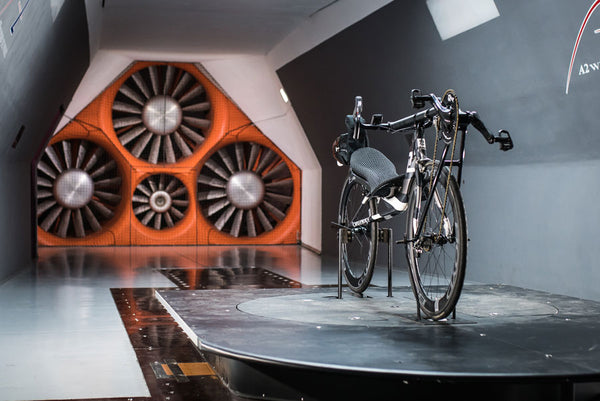
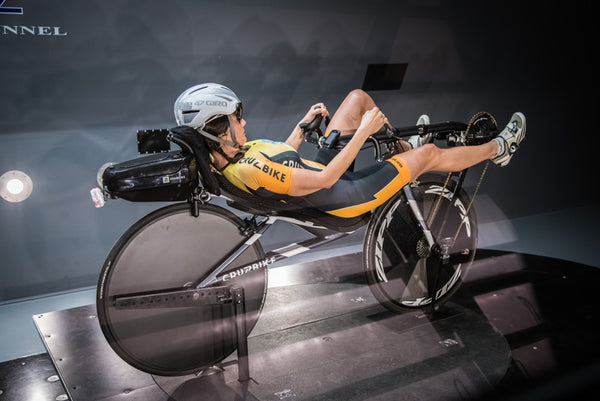
Another success was a prototype of a customer-designed frame pack called the “Moosepack” that fits under the seat. This saved 3.8 Watts at 0 yaw and was neutral at 7 degree yaw. Nice work @trplay! Look for the Moosepack to become available later in 2017.
It also appears that having two bottles in the Headrest Cage Mount is more aero than having no bottles in there by a surprising 7.8 Watts. Take that number with a grain of salt because that data was in the set affected by the clearance issue. However, it is consistent with other tests of objects behind our heads improving CdA.

The Ninja V18 adapters, which make the V20 effectively a V18 (still in prototype testing) saved a solid 8 Watts at 0 yaw and had no effect at the oblique angle. This was in the valid data section so I have high confidence with that number. Keep in mind this was only tested by me. I suspect the benefit would be less for a shorter rider (I am 74 inches tall).

Probably the most important lesson we learned was that Maria needs to stick with the standard chainstay size. Not only did the data show that using the large chainstay cost her Watts, but the camera angles were very useful in showing how the longer chainstay put her knees into the clean airstream above her shoulders, more than a lower chainstay put her heels into the clean airstream below the seat. She is going back to the standard chainstay; and compensating for the higher handlebar position by using the Curved Slider to lower her hands again. I can’t calculate an exact power-savings for her on this one because of the clearance issue, but estimate about 3 Watts.

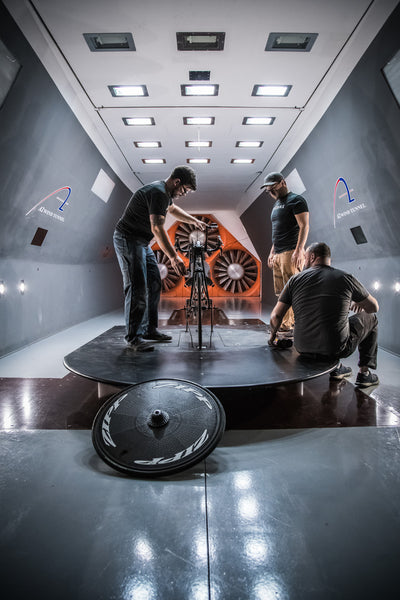
Wheels: We tested three types of wheels that Cruzbike carries: the practical narrow-rim Velocity wheels, the 60 mm deep-rim Boyd wheels, which we will be offering as an upgrade, and a rear (non-drive) Carbon-King full disk wheel. As expected, a full disk wheel is more aero than a deep rim wheel, which is more aero than a thin rimmed wheel. We also tested a Zipp full-disk drive wheel (which we don’t sell). That was ridiculous. Here are the detailed results for Maria, with the Watts required to go 24 mph: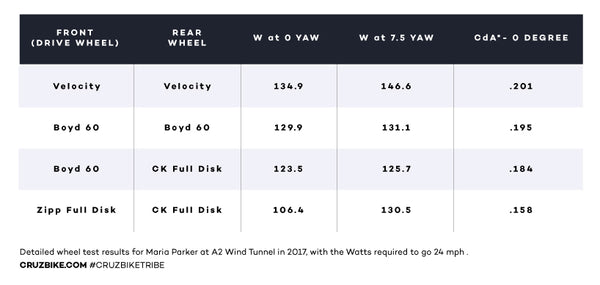
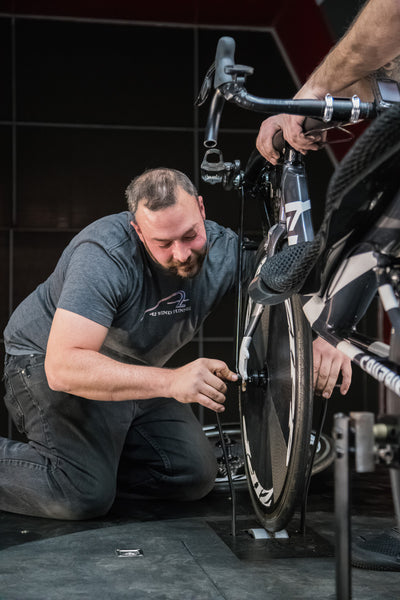
Playing with Smoke
Towards the end of the day, Geoff broke out the smoke machine while I pedaled the V20 into the 30 mph blast. With the smoke whipping into my Oakleys, I felt like a Hellfire missile heading for the tailpipe of a MiG-23. In addition to the stunning visual phenomenon, the smoke helped us trace the path of the air currents and identify areas of the dreaded vortex. We saw a very smooth flow under the seat with little disturbance. Most of the turbulence, as expected, was behind the back and headrest.

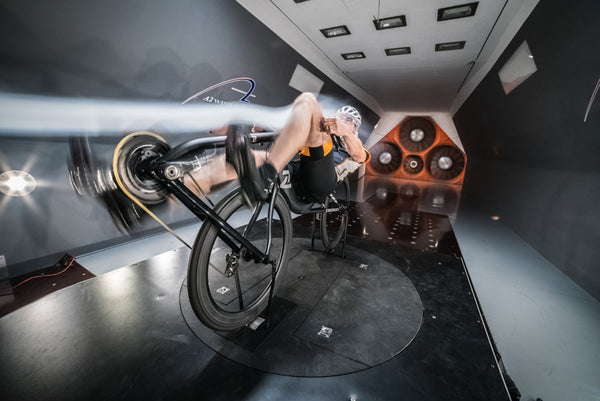
Conclusions
Overall, we learned a lot. The CdA numbers that were calculated in the wind tunnel were in close agreement with numbers calculated using the Chung Method (loop course, little or no wind, power meter running, don’t touch your brakes, upload the data to the application). We have often used the Chung method to decide which bicycle set-ups and what equipment to use in racing. It’s great to know that it works! We’d observed that for us to ride side-by-side at 24 mph, I will need to put out about 35-40 more Watts then Maria. This was confirmed in our A2 Wind Tunnel Testing.
So how do we compare to upright bikes and other recumbents?
Maria’s CdA (metric units) as measured in the A2 Wind Tunnel was consistently less than 0.200 and down to .158 with dual disk wheels. Mine was consistently about .230, while Larry’s was in-between, but closer to Maria’s. By comparison, the CdA for an optimized Time Trial bike with a professional rider in aerobars is .270 according to the Cycling Power Lab website. For more reading about CdA for different positions on a typical road bike go here and scroll to the bottom of the page for charts.
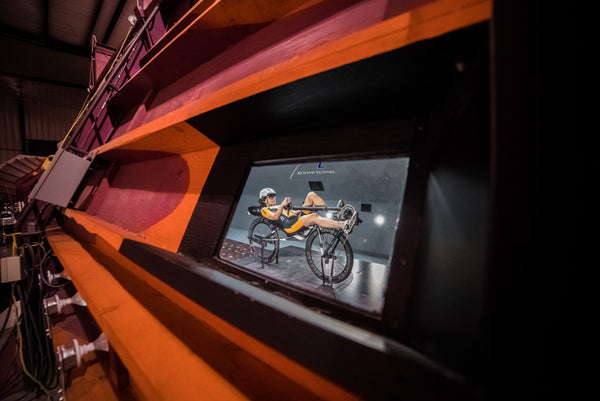
There isn’t much published wind tunnel data for other recumbents. But, Robert Holler found these results from Vision Recumbent tests in 1999.
The Vision Recumbent (VR) tests were done on two models of VR bikes and an upright bike. The most aerodynamic bike they tested was the Vision 65ET (Saber). The results were given in pounds of drag with a rider who was 5’ 10” tall and weighed 150 lbs. In a 30 mph wind tunnel, the rider and bike produced 7.0 lbs of drag, which is 3,181 grams. The same rider produced 7.0 lbs. of drag on a road bike in the aero tuck position.
To compare the V20’s performance: Maria produced about 1,900 grams of drag (60% of the rider+Saber), and big me, wearing a baggy jersey, produced 2,300 grams (5.06 lbs, or 72% of the drag of the Saber).
It was exciting to spend the day adding up-to-date to scientific information about the aerodynamics of the Cruzbike V20. Much of what we learned confirmed what we suspected, but as it says on the wall of the offices of the A2 Wind Tunnel:
“One good test is worth a thousand expert opinions.”
― Wernher von Braun



Il CDA di 0,27 and too high. I agree with Jonathan .
All things being equal, the older assumed drag coefficient for a trapezoid bike is still valid – nobody is going to ride a century race in the most extreme aerotuck position, nor are they going to ride a 7 kilo bike on a country road. Likewise for additional variables such as expensive aero fabrics, etc. The 40% lower drag coefficient is completely believable.
https://gccoaching.fit/2016/11/05/get-faster-on-flat-roads-wattscda/
The 0.27 CDA on a TT number seems rather outdated or wrong for describing dialed in pros. Check the hour record numbers, and even without the dual disc indoor setup you would still expect around 0.16-0.2 ( Bigham has a 0.15).
Assume!
Leave a comment